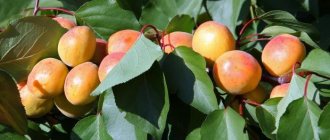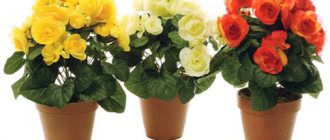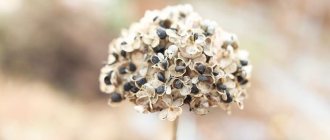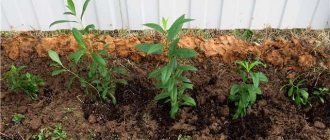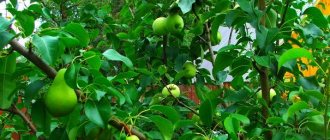What to choose – planting or digging in seedlings
Plants can be planted in a permanent place one month before the onset of frost. During this time, the root system of the seedling has time to adapt to new conditions, and the tree overwinters without significant losses. Later planting often leads to freezing. In this case, only 30% of fruit trees of frost-resistant varieties survive, and they become completely unstable to diseases and damage by pests.
Plants can be planted in a permanent place until mid-October or until the temperature reaches 0...+2 °C in cases where the seedling:
- purchased with a closed root system;
- strong, well developed, 3–4 years old;
- frost-resistant variety.
Replanting a tree is a lot of stress, but the procedure of planting for the winter cannot be avoided in the following cases:
- late acquisition of planting material;
- absence or unavailability of a place for permanent placement;
- if the plant is weak, it has few branches or an undeveloped root system;
- if the plant is heat-loving, such species can be planted in a permanent place only in early spring.
The preservation of the root system of a buried plant is ensured by the greater thickness of the soil.
When to cover a plum before winter
The table below indicates when, as well as under what weather conditions, it is necessary to cover the plum, taking into account the temperature characteristics of various natural and economic regions.
Table
| Region | Month | Average daily temperature | Weather |
| Moscow region | December | -4°С | Dry, windless |
| Middle lane | December | -5°C | Dry, windless |
| Ural | november | -3.7°C | Dry, windless |
| Siberia | December | -5°C | Dry, windless |
| Leningrad region | December | -3°C | Dry, windless |
| Transbaikalia | november | -10°С | Dry, windless |
| Far East | December | -5°C | Dry, windless |
| Khabarovsk | november | -8°С | Dry, windless |
| Volga region | December | -3.5°C | Dry, windless |
Selecting a location
The place for digging in seedlings should be selected according to the following indicators:
- the area must be dry, level and protected from the wind;
- it is important to exclude the possibility of flooding of the seedling - you should avoid lowlands in which rain or melt water can accumulate;
- to avoid freezing, do not bury trees on a hill;
- You should avoid areas located in close proximity to a house, garage or shed, as well as near a compost heap or lawn - rodents often hibernate in such places.
Process technology
The process of planting a seedling for the winter consists of several stages, and compliance with the requirements for each of them guarantees the preservation of the viability of the plant.
Ditch preparation
The trench for the trench must meet the following requirements:
- pit width – 30–60 cm per plant, depending on the size of the root system;
- for digging in several seedlings, the width of the ditch should be based on the calculation of 25–45 cm per plant, while the direction in length is from east to west;
- the depth should be 35–60 cm depending on the length of the seedling - 2/3 of its part should fit in the ditch;
- the northern side of the ditch should be vertical, the southern side should be at an angle of 40–45° relative to the horizon.
Preparation of seedlings
Preparation of seedlings consists of several stages:
- Inspection of the plant . If you find wounds, cracks or broken branches on the bark of a seedling, you should carefully clean the damaged area with a sharp knife and cover it with garden varnish or white oil paint.
- Leaf trimming . Most often, the leaves of autumn seedlings fall off when lightly pressing the cuttings. If this does not happen, you should not break them out with force - you should cut them with pruners at a distance of 1–2 mm from the stem. This procedure is carried out in order to preserve moisture in the plant tissues and increase frost resistance.
- Moisturizing and disinfecting roots . Required to saturate the seedling trunk with moisture and protect against putrefactive diseases. To do this, immerse the plant root in water for 2–3 hours, then for 20–30 minutes in a pink solution of potassium permanganate (potassium permanganate).
- Preparing and trimming roots . Before planting the seedling, the moistened root system should be inspected for damage. Dry, broken or rotten roots should be carefully trimmed with pruning shears and then sprinkled with wood ash.
If you plan to bury seedlings of several varieties of fruit trees before spring, then to identify and distinguish them, you should make plastic tags and secure them to the trunk with wire.
Seedlings with a closed root system should be placed in a ditch with a whole ball of earth, and it is necessary to inspect the trunk and trim the leaves.
Soil preparation
The soil for planting seedlings should be fertile, loose and light. To create the required consistency, you need to mix the soil dug out of the ditch in equal proportions with rotted compost and river sand.
Dropping
The instillation process looks like this:
- Prepared seedlings should be placed in a ditch at a distance of 25–30 cm from each other, with the roots facing north and the trunk lying on the gently sloping southern wall. This arrangement reduces the likelihood of barrel burns.
- Cover the roots with prepared soil and water with warm water to fill air voids. At the same time, it is important to prevent waterlogging - the soil must dry out before the onset of the first frost.
- Fill the ditch with earth to the ground level , and it is important to ensure that the tree trunk is sprinkled 15–20 cm above the scion site.
- Compact the soil in the ditch and create a mound 7–10 cm high.
In regions with a harsh climate (in Siberia, the Urals and the north), the ditch should be filled 15–25 cm above the ground level. The resulting mound protects the roots from freezing.
There is no need to remove 1/3 of the central conductor of the seedling before planting. This pruning should be done when planting a tree in a permanent place in the spring.
Protection from frost and pests
Insulation of buried seedlings should be carried out after the ambient temperature drops to -5...-7 °C. For this purpose, it is best to use a special material, spunbond or lutrasil. In winters with little snow, the burial site must be additionally insulated by adding and compacting snow.
The following should be used as protection against rodents:
- covering the protruding part of the seedling with spruce branches;
- mandatory compaction of the snow cover around the perimeter of the ditch and at the burial site.
Even more tips: How to save seedlings purchased in the fall until spring
Spring treatment
Seedlings should be released from the digging site in early spring immediately after the snow melts. It is impossible to delay replanting a tree, since with the beginning of sap flow, the development of young roots begins, which are damaged during digging and subsequently do not take root well in a permanent place.
The process of spring preparation of a seedling dug in in the fall is as follows:
- To avoid damping off of the seedling, snow should be removed from its open part at the end of March.
- At a stable temperature of -5...-7 °C, remove the covering insulating material.
- At the beginning of April or when a stable temperature reaches +5...+10 °C, the ditch should be carefully dug out. To do this, first of all, you need to remove the top layer of soil, then dig up the seedling with a shovel. It is important not to damage the roots and trunk of the tree.
- Remove the seedling with a lump of earth from the ditch. At the same time, it is forbidden to pull it out or remove it by swinging - such actions will lead to the destruction of the scion site.
- Inspect the trunk of the seedling. If there is damage, carefully cut off the bark with a sharp knife and cover it with garden varnish.
- Inspect the roots. Remove rotted and weak shoots. Soak in a solution of the drug “Kornevin”, diluted according to the attached instructions.
- Add fertile soil with humus or rotted compost to the hole prepared in spring and water with warm water.
- Trim 1/3 of the central conductor and plant the plant in a permanent place.
How to preserve unplanted corms until spring?
Paper or special plastic perforated bags, small cardboard boxes in which tulips, daffodils, lilies, onions, daylilies, hostas, bergenia, irises and other plants can be covered with wet peat or sawdust, sand or sphagnum, will successfully preserve them until spring, provided the correct temperatures
Plants that are not planted on time should overwinter in a cool place, at a temperature of 2 to 5 degrees, in a dark, ventilated place and in dry conditions. Higher temperatures will cause premature germination. Sawdust or peat should be kept slightly moist.
If the sprouts on bulbs, tubers or rhizomes are actively growing (up to 8-10 cm), in order to preserve the plants, they will need to be planted in pots and placed in bright light. If forcing for rooms does not interest you, then at low temperatures and in the soil the plants can be kept until spring, and then carefully transferred into holes in the desired place in the garden.
Perforated bags with corms can be filled with wet peat or sawdust, sand or sphagnum. © Orchardo
Dear readers! The same tips will also help in the spring, if you received seedlings long before the start of real, not calendar spring. After all, the new sales season opens in March, and in the middle zone the first purchases somehow need to be saved until the soil thaws and the weather warms up. For plants with awakened buds, the same conditions are needed as for “sleeping” ones, but with one important exception - such seedlings are placed in bright light, and not in a dark place.
Possible mistakes
When planting seedlings, it is necessary to avoid mistakes that can lead to the death of the plant:
- Excessive watering or wetting of the seedling trunk . When the temperature drops sharply, the moisture turns into pieces of ice, which can freeze the root or damage the trunk.
- Shallow ditch . The main conditions when determining the depth of the hole are the immersion of the seedling by at least 2/3 of its full size and the obligatory digging of the grafting site and trunk.
- No watering when digging . Leads to the formation of voids in which the root system, with high-quality insulation, evaporates, and in severe frost conditions, freezes out.
- Using sawdust as insulation . Shredded wood absorbs moisture well, which hardens when the temperature drops. Thus, frozen sawdust enveloping the unburied trunk damages the bark, which leads to its freezing. In addition, such a compressed mass takes a long time to thaw in the spring, which contributes to the damping off of the seedling.
- Using dry leaves or straw as insulation . Rodents spend the winter in such places and are capable of destroying a young seedling to the ground.
- Early insulation with covering material . Leads to damping off of the young tree.
What to do if you didn’t cover the cherries on time
In the event that you have not visited your summer cottage for several weeks and have not had time to protect the cherries from frost, all further actions will depend on the duration of the cold snap. If an increase in temperature is not expected and the fallen snow is not going to melt, you can heat it onto the trunk at the first opportunity , thereby insulating the area near the trunk. At the same time, if there is the slightest likelihood of a decrease in temperature values, it is better to limit ourselves to the use of covering material or a box that completely covers the crown of the young seedling.
Important! Mature trees of frost-resistant cherry varieties do not need shelter even in the northern regions of the country, so in preparation for winter it will be enough to simply whiten the bark, cultivate the soil and, if necessary, heat a layer of fallen snow on the base of the trunk. But sheltering young seedlings of such plants should always be done.
Mature plants growing in the southern territories most likely will not need shelter at all, especially if we are talking about frost-resistant varietal varieties.
